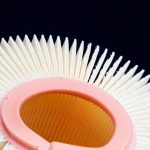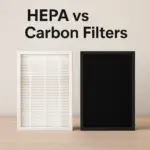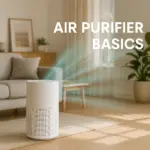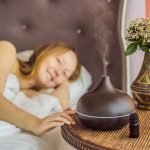Table of Contents
Where’s the Best Place to Put an Air Purifier?
Air purifier placement can make or break its performance. Even the most powerful unit will struggle if it’s stuck in a corner, hidden behind furniture, or placed too low. By positioning your purifier where air naturally circulates, you’ll capture more dust, dander, smoke, and allergens—and feel the difference faster.
In this guide you’ll learn the best placement strategies for every room, how to adjust for specific pollutants, common mistakes to avoid, health and safety considerations (including ozone), when to use more than one unit, and how to pair a portable purifier with a whole‑home UV solution.
1. Why Placement Matters
Air purifiers pull in contaminated air through an intake vent, trap particles in a filter, and push clean air back into the room. If the intake is blocked or the purifier sits in a dead zone, circulation drops and fewer pollutants reach the filter.
- Near a wall: Reduces intake from multiple directions.
- Behind furniture: Blocks both intake and outlet vents.
- Too low: Misses airborne pollutants circulating higher in the room.
Comfort matters too. A purifier blowing directly on your face can dry your nose and throat; placing your face right next to the intake can pull unfiltered air past you before it’s cleaned. If you’re still choosing a unit, see The Hidden Dangers of Ionized Air Purifiers.
2. Best Placement for an Air Purifier
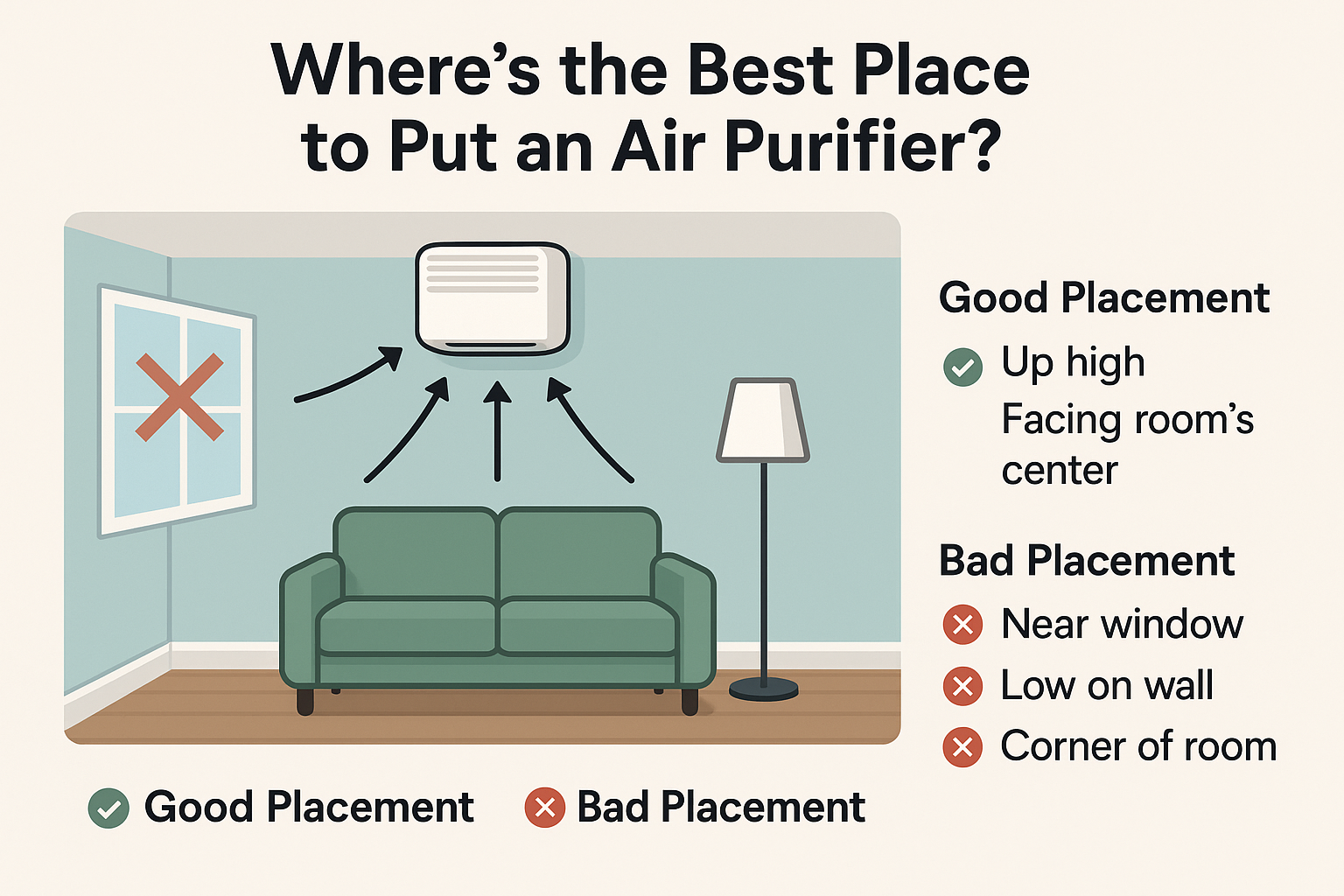
As the diagram shows, an elevated, central location lets the purifier pull air from all directions and redistribute clean air evenly—preventing “clean pockets” near the device and stale areas elsewhere.
3. General Placement Guidelines
- Height matters: Aim for 5–6 feet from the floor to reach the breathing zone and improve room-wide circulation.
- Keep it central: Middle of a wall or open area beats corners and alcoves.
- Clear the vents: Leave 2–3 feet of clearance around intake and outlet.
- Mind the intake path: Don’t position the intake so it pulls unfiltered air across your face in seating or sleeping spots.
- Face the room: Angle the outlet toward where people spend time, not a wall.
4. Room-by-Room Placement Guide
Most rooms have unique airflow, noise concerns, and pollutant sources. Use this guide to tune placement for each space.
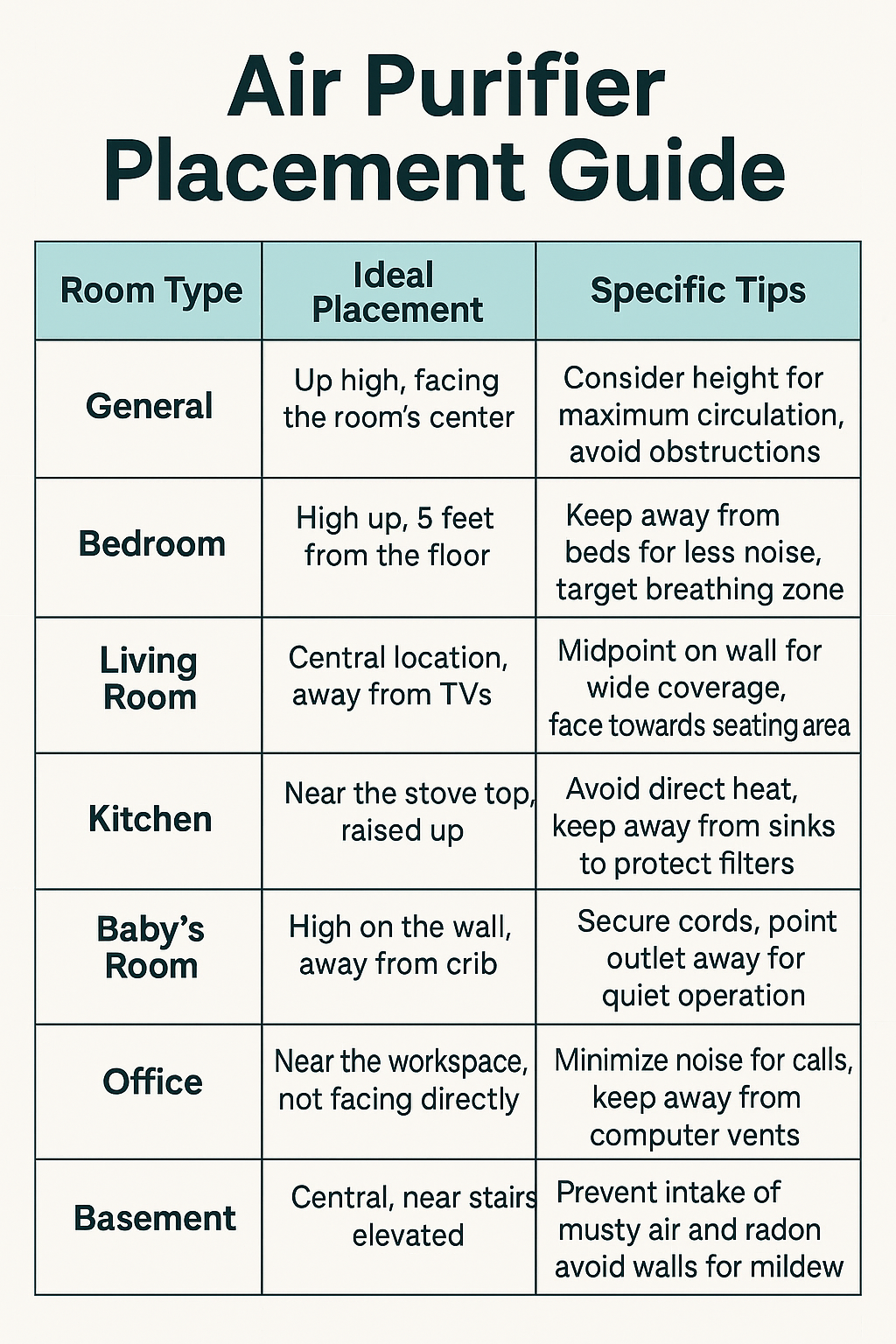
| Room Type | Ideal Placement | Why It Works |
|---|---|---|
| 🛏️ Bedroom | High up, ≥5 ft | Circulates clean air through the breathing zone without pulling pollutants past your face. Place opposite the bed if noise is a concern; use sleep mode at night. |
| 🛋️ Living Room | Central, away from electronics | Even coverage across seating areas. Keep a few feet from TVs/speakers to avoid heat/noise interference. In open concepts, place between seating areas—not in a corner. |
| 🍳 Kitchen | Near stovetop, raised | Intercepts smoke/odors before they spread. Don’t put directly above the stove; keep ≥3 ft from the sink to protect filters. |
| 🍼 Baby’s Room | High wall, away from crib | Keeps buttons/cords out of reach and reduces noise by angling the outlet away from the crib. |
| 💻 Office | Near desk, angled away | Filters your breathing zone without drying your eyes. Keep a few feet from computer vents. |
| 🏠 Basement | Central/elevated, near stairs | Improves circulation in stagnant spaces and helps clean air reach upper floors. Elevate to avoid pulling damp/radon-heavy floor air. |
Small adjustments—raising the unit a foot, angling the outlet toward seating, or moving a few feet from a wall—can noticeably improve results.
5. Placement for Specific Pollutants
Pollutants behave differently. Smoke rises quickly, pet hair collects low, and dust is easily stirred. Target them with tailored placement.
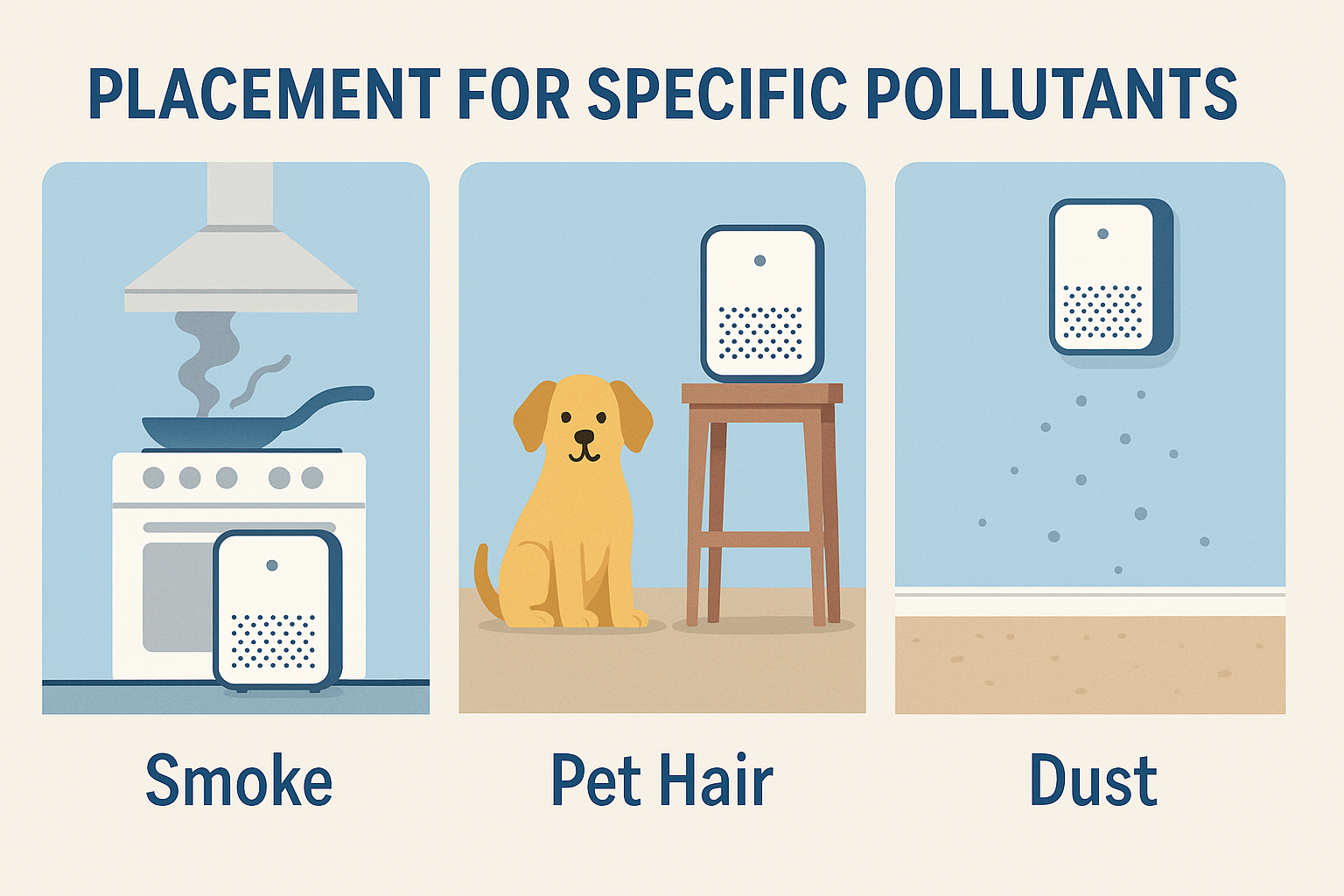
Smoke
- Place within 3–6 ft of the source—but never directly above heat.
- Use a counter/wall-mount elevation to intercept smoke quickly.
- In large rooms, angle the outlet toward open areas to push clean air into the flow path.
Pet Hair & Dander
- Keep near pet zones but raise 1–2 ft to reduce hair clogging.
- Ensure a clear intake path; don’t block with beds/furniture.
- Run higher fan speeds during shedding/grooming.
Dust
- Mount 4–6 ft high to catch airborne dust before it settles.
- Position where sunlight reveals floating particles—often active air currents.
- Vacuum/dust regularly so the purifier stays effective.
6. Avoid These Bad Placement Spots
Certain locations create airflow problems, reduce efficiency, or let pollutants bypass the filter entirely.
- Near windows: Outdoor pollutants enter before filtering; keep ≥3 ft away from open windows.
- Inside closets/cupboards: Airflow is blocked; room air isn’t cleaned.
- Corners & alcoves: Stagnant “dead zones” limit reach.
- Behind furniture: Blocks intake/output vents.
- Next to HVAC vents: Disrupts purifier airflow patterns.
- Face-level outlet: Can cause dryness if blowing directly on you for hours.
Think of a purifier like a fan in reverse: it needs a clear path to pull dirty air in and push clean air out.
7. Can the Wrong Air Purifier Placement Make You Sick?
Most purifiers improve health by reducing airborne pollutants. Poor placement, poor maintenance, or the wrong type of unit can cause irritation or worsen symptoms.
- Intake path risk: If you sit/sleep right next to the intake, dust, pollen, smoke, and dander can be drawn past your face on their way to the filter.
- Outlet too close: Air blowing directly at you for hours can dry your nose, throat, and eyes.
- Ozone-producing models: Some ionizers/ozone generators emit ozone, which can irritate lungs and aggravate asthma. If your purifier emits ozone, see What to Do If Your Purifier Emits Ozone and The Hidden Dangers of Ionized Air Purifiers.
- Dirty/moldy filters: Neglected filters can harbor and re-release irritants.
- Wrong room choice: Running a purifier in a damp, moldy room without fixing moisture can recirculate unhealthy air.
Solutions: keep a few feet from beds/sofas, angle the outlet away from faces, maintain filters on schedule, and avoid ozone‑producing devices in occupied spaces.
8. When You Need More Than One Air Purifier
One purifier only treats its immediate area. Large homes, open concepts, and multi-story layouts often need more than one unit.
Signs You Need Multiple Units
- Room size exceeds the unit’s CADR/square-foot rating.
- Open concepts with multiple pollutant sources (kitchen + living).
- Multi-level homes (air doesn’t travel efficiently between floors).
- Persistent dust/odors in multiple rooms.
How to Place Them
- Opposite sides of a large room: Face toward center for balanced airflow.
- Target sources + people: One unit near pollutant sources, another where people gather.
- Stairs as support: A unit near stairs can cut inter-floor transfer; still keep a unit per level.
9. Pairing with an HVAC UV System
For whole-home coverage, pair a portable purifier (captures particles where you live and breathe) with an HVAC UV system (neutralizes germs in the ductwork).
- Portable purifier: Captures dust, dander, smoke, and allergens in key rooms.
- HVAC UV light: Kills mold spores, bacteria, and viruses as air circulates.
Benefits: cleaner coils/ducts, fewer germs circulating, silent always‑on operation. Learn more in Pros and Cons of UV Light in HVAC.
10. Seasonal Placement Adjustments
Winter
- Keep away from heating vents that distort airflow.
- Prioritize closed rooms where you spend more time indoors.
- If air feels dry, angle outlet away from faces/sleeping areas.
Summer
- Give AC vents space so they don’t overwhelm intake or blow clean air away.
- During pollen season, place near frequently used doors/windows.
- In humid areas, use dehumidification in damp spaces; don’t pull in wet air from the floor.
Shoulder Seasons
- Move units between rooms as needs change.
- Watch sunlit zones that reveal floating dust—great targets for placement.
11. Special Placement Scenarios
Allergy Season
- Place near entry points and windows to capture pollen early.
- Run higher fan speeds during morning/evening peaks.
During Illness
- Keep a purifier in the patient’s room; position intake to pull air away from others.
- Angle outlet toward doorway/hall to send cleaner air outward.
- Avoid the intake path passing directly by the patient’s face.
After Cleaning
- Vacuuming/dusting stirs particles—run higher speed for 30–60 minutes.
- Central placement captures stirred dust from multiple surfaces.
Hotel Rooms, RVs, Vacation Homes
- Hotels: near the bed, outlet angled away from your face.
- RVs: near cooking or sleeping zones depending on use.
- Unused homes: start in mustiest room, then move as odors clear.
12. Testing Your Placement
Verify performance—tiny moves can make big differences.
Use Built‑In Sensors
- Run auto mode; note how fast it returns to “good.”
- Try another spot; compare times.
Standalone Monitors
- Use PM2.5/VOC meters; measure before and 30 minutes after.
When to Move It
- Persistent odors or dust accumulation.
- Uneven airflow—breeze on one side, stale on the other.
- Allergy/asthma symptoms persist in certain rooms.
Test for a full day in each spot; airflow can shift with weather, HVAC cycles, and activity.
 13. Key Takeaways
13. Key Takeaways
- Place purifiers 5–6 ft high, central, and unobstructed; face the room.
- Match placement to the room and to the pollutant you’re targeting.
- Avoid dead zones: corners, closets, behind furniture, and right by HVAC vents.
- Keep the intake away from your breathing zone and maintain filters on schedule.
- Use multiple units for large/open/multi‑floor homes.
- Consider HVAC UV for whole‑home germ control.
- Test placement with sensors/monitors and adjust seasonally.
With smart placement and consistent use, your air purifier will deliver cleaner, healthier air where you need it most.

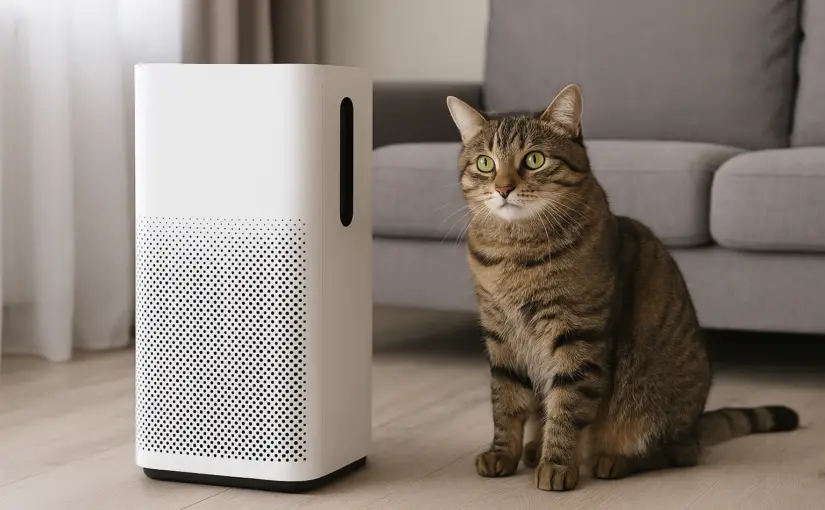
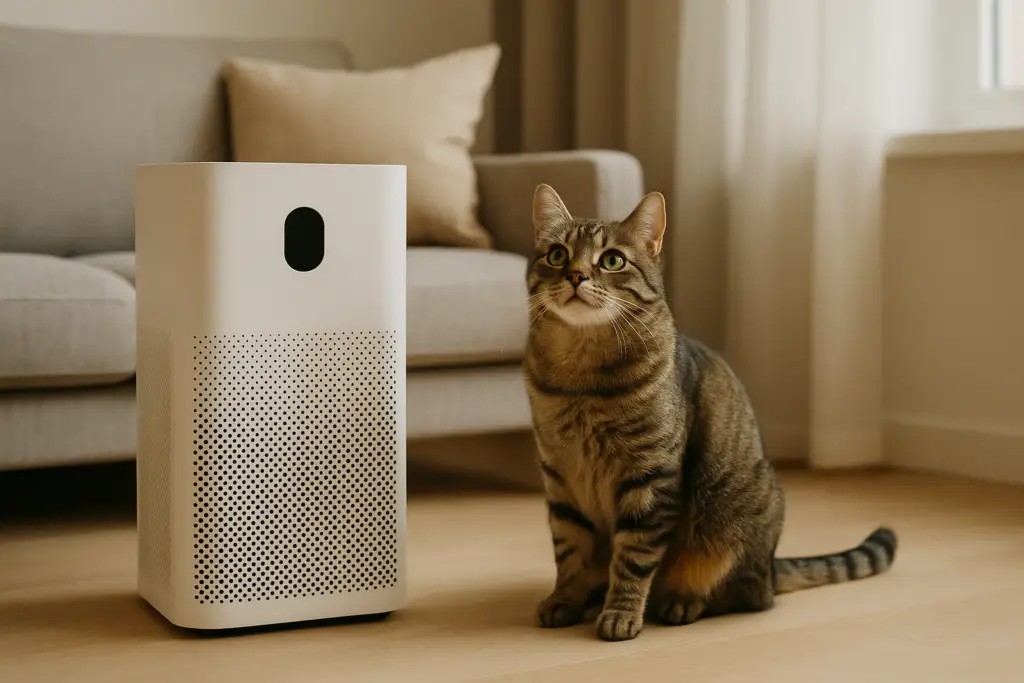 13. Key Takeaways
13. Key Takeaways